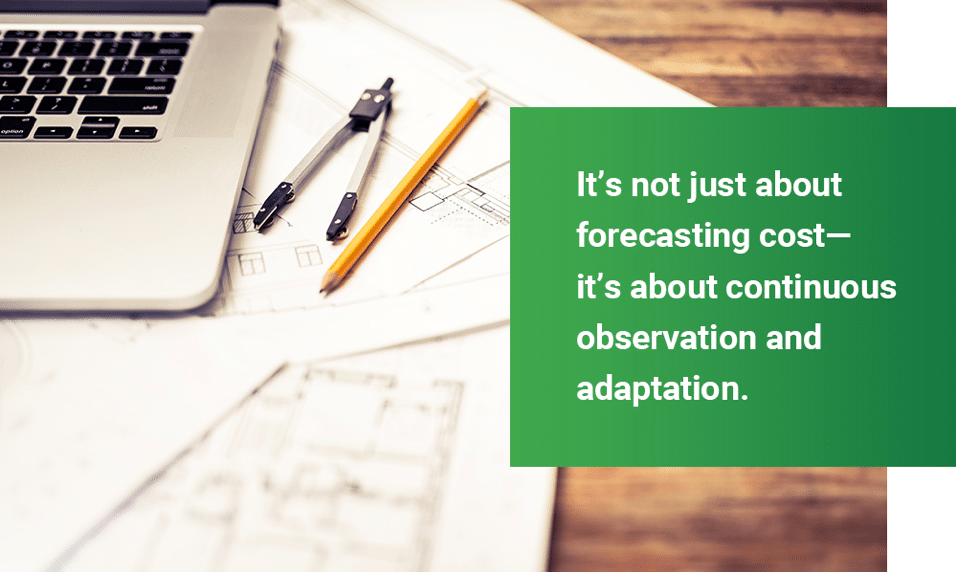Construction is all about planning—the adage “measure twice, cut once” has been a persistent piece of advice through the ages for a reason. In our field, every step needs to be thoughtfully considered before any ground is broken. There are many moving parts in even the smallest job. Pitfalls are found everywhere throughout the process of building, but with enough experience, you learn to identify the most common problems and you become better equipped to avoid them.
Exceeding the Estimated Budget
Everyone has fallen victim to going over budget for one reason or another. Preparation is the key to doing accurate cost analysis on any job, large or small. In order to truly estimate a budget, you need to picture the entire project in your head from start to finish. Any “what if” scenario along the way should be considered and accommodated. After all, we’ve all learned a thing or two about Murphy’s Law in our careers.
We’ve found that having people on our team that focus on continuous cost analysis keeps us on time and on-budget. It’s not just about forecasting cost—it’s about continuous observation and adaptation. It’s much easier to see when a budget is getting off course if you’re constantly vigilant. Our people have been doing this a while, so they understand how to correct the ship if it begins to veer off course. A lot goes into our budgeting and it’s a never-ending process to ensure it’s accurate and competitive.
Scheduling Conflicts
We’ve all waited for someone that’s given us a time window, only for them to not show up at all. It’s not a good feeling to wait on someone, especially if they forgot to tell you they’ve pushed back their arrival or canceled it altogether.
In construction, there are many things happening at once day-to-day. Coordinating manpower is a full-time job that we take seriously. We’ve invested in project management software that allocates and schedules manpower, ensuring we have no conflicts with who needs to show up where. We understand that if you’re late too many times, or don’t show up at all, then you’re going to quickly lose the trust of your clients.
Managing Expectations
A client’s expectations can go in either direction. Sometimes they’re so intent on finishing a job that they’re not looking far enough forward. Sometimes what they want isn’t possible with the time and budget constraints allocated. Managing expectations takes tact, thorough knowledge of the industry, and an out-of-the-box way of thinking. Neglecting your client’s expectations will leave them feeling unsatisfied, regardless of how well you think the project went. At the end of the day, it’s up to your client to tell you if you’ve succeeded or not.
We try and balance what is realistic with what boundaries we can push for our clients—we’re all about going the extra mile. Baccus Oliver, Principal/Project Manager, has found a delicate balance between managing and exceeding client’s ambitions.
“Communication of expectation is incredibly important. Most clients sometimes don’t know what could be. We as designers/builders must understand their needs and communicate the possibilities that can push their project further. Most of all, we all need to agree on the project’s main goals and move forward with a strong vision.”
Getting the Proper Permits
If you’re familiar with construction, then you know you can’t just start breaking ground, even in the most remote areas. In fact, there’s almost nothing you can do without the proper permit. This is a good thing—there’s a lot that you can disrupt below and above ground if you’re not sure about what you’re doing. Proper permits ensure you’re building safely while also protecting the environment. Safety can look different depending on the terrain, the zoning, and the type of structure you’re working on.
We have a team of people that know every permit up and down. They understand who to talk to, what is needed for proper building, and when to start the permit process. Not having the right documentation at the right time is the difference between a fruitful day of progress and a day where everyone goes home early due to a closed site. Lost time isn’t just lost revenue—it’s losing the trust of your client.
Poor Communication & Collaboration
Nothing can kill a project faster than poor communication. It’s easy, in the heat of the moment, to cut corners or make assumptions, no matter how small, that eventually build into something much larger than the sum of its parts. Nothing will twist your stomach into knots faster than realizing you’ve strayed far from your client’s vision without even realizing it.
Proper and continuous communication coupled with productive collaboration is the key to staying on target. You want to involve your client as much as possible. Not only will it empower them, it will elevate the project into something inspired. Without constantly getting input from your client, it’s hard to stay on course, or even know where the course is. We involve our clients throughout the process, and we’ve developed a delicate balance of involvement that doesn’t feel overwhelming but instead collaborative through practical design.
We Use Vigilance & Experience to Excel
Pitfalls may be common, but they aren’t so easily avoided without vigilance and experience. Every mistake we avoid in our day-to-day work was one we’ve seen or even committed ourselves, large or small, at some moment in our careers. We learn from our most challenging experiences, and we’ve all come together to build a team of diverse people that have decades of experience in many facets of construction. At this point, we’d say we’ve seen it all, but we’d rather not test our luck!



